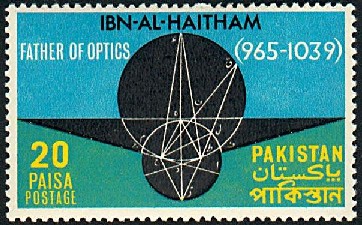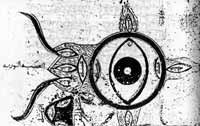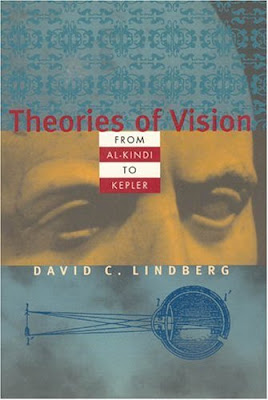Abu Ali Hasan Ibn al-Haitham, or Alhazen, as he is known in the West, was one of the most eminent Moslem physicists, whose contributions to optics and the scientific methods are outstanding. He was born in 965 A.D.in Basra, Iraq and received his education in Basra and Baghdad. Ibn al-Haitham, who died in 1039 AD in Cairo, was a great scientist and engineer. On a trip to Egypt to study the Nile River, he recommended building a dam at Aswan to store the summer floodwater upstream and use it throughout the year. This project was finally executed in the 20th century!
He also travelled to Spain and, during this period, he had ample time for his scientific pursuits, which included optics, mathematics, physics, medicine and development of scientific methods on each of which he has left several outstanding books. His extensive researches on optics, has earned him the title “ Father of modern Optics”.
Ibn al-Haitham made a thorough examination of the passage of light through various media and discovered the laws of refraction. He also carried out the first experiments on the dispersion of light into its constituent colours. His book Kitab-al-Manadhir was translated into Latin in the Middle Ages and taught in European colleges, along with his book that was dealing with the colours of the sunset.
He described in details the physical phenomena of shadows, eclipses, and rainbow and speculated on the physical nature of light. Al Hazen was the first scholar to describe accurately the various parts of the eye and give a scientific explanation of the process of vision. He also attempted to explain binocular vision, and gave a correct explanation of the apparent increase in size of the sun and the moon when near the horizon. He contradicted Ptolemy's and Euclid's theory of vision that objects are seen by rays of light emanating from the eyes; according to him the rays originate in the object of vision and not in the eye.
We know little of Ibn al-Haytham's years in Basra. It appears that he did not devote himself to the study of mathematics and other academic topics at a young age but trained for what might be best described as a civil service job. He was appointed as a minister for Basra and the surrounding region. However, Ibn al-Haytham became increasingly unhappy with his deep studies of religion and made a decision to devote himself entirely to a study of science, which he found most clearly described in the writings of Aristotle. Having made this decision, Ibn al-Haytham kept to it for the rest of his life devoting all his energies to mathematics, physics, and other sciences.
Ibn al-Haytham went to Egypt some considerable time after he made the decision to give up his job as a minister and to devote himself to science, for he had made his reputation as a famous scientist while still in Basra.
In Cairo, where he lived part of his life, he spent much of his time conducting experiments, of which many involved a dark room with a hole in it. He hung five lanterns outside the room, adjacent to the wall with the hole, and noticed that there were five 'lights' on the wall inside his dark room. He would then place an obstruction between one of the lanterns and the hole, and observed how one of the 'lights' on the wall disappeared. Furthermore the lantern, the obstruction and the hole were in a straight line.
This demonstrated that light travelled in straight lines and that, even though the light from the five lanterns all travelled through the little hole at the same time, it did not get mixed up: there were five 'lights' on the wall inside the room. Ibn al-Haitham deduced that this is how the eye worked, which had been the subject of a long debate. Aristotle had believed that the eye sent out rays to scan objects, but Al Hazen believed that the opposite is true - that light was reflected into the eye from the things one observed, thus overturning a thousand years of scientific thought. His experiment was the first scientific description of the 'camera obscura' (dark room), the principle behind the pinhole camera.
In detailing his experiment with spherical segments (glass vessels filled with water), he came very close to discovering the theory of magnifying lenses, which was developed in Italy three centuries later. It took another three centuries before Snell and Descartes proposed the law of sines.
Ibn al-Haitham's scientific approach differed from that of the Ancient Greeks in that they saw that truth was determined by the logic and beauty of reasoning, and when experiment was used it was only as a demonstration. That's the reason why Ptolemy, even though he did experiments, has supported the erroneous "emission" theory of vision. In contrast, Ibn al-Haitham saw experiments as being the essential factor that distinguished a true theory from a false one - through this insight he created the foundation for the "scientific method".

Al Hazen’s research in catoptrics focused on spherical and parabolic mirrors and spherical aberration. He made the important observation that the ratio between the angle of incidence and refraction does not remain constant and investigated the magnifying power of a lens. His catoptrics contains the important problem known as “ Alhazen's problem”. It comprises drawing lines from two points in the plane of a circle meeting at a point on the circumference and making equal angles with the normal at that point. This leads to an equation of the fourth degree. He also solved the shape of an aplantic surface for reflection.
Ibn al-Haytham's writings are too extensive for us to be able to cover even a reasonable amount. It seems that he has written over 200 scientific works, of which remarkably, 55 have survived. The main topics on which he wrote were optics, including a theory of light and a theory of vision, astronomy and mathematics, including geometry and
number theory. We will give at least an indication of his contributions to these areas.
In his book Mizan al-Hikmah, Ibn al-Haitham has discussed the density of the atmosphere and developed a relation between it and the height. He also studied atmospheric refraction and discovered that the twilight only ceases or begins when the sun is 19° below the horizon and attempted to measure the height of the atmosphere on that basis. He has also discussed the theories of attraction between masses, and it seems that he was aware of the magnitude of acceleration due to gravity.
Ibn al-Haitham's contribution to mathematics and physics is extensive. In mathematics, he developed analytical geometry by establishing linkage between algebra and geometry. In physics he studied the mechanics of motion of a body and was the first to propose that a body moves perpetually, unless an external force stops it or changes its direction of motion. This is strikingly similar to the first law of motion. He has also discussed the theories of attraction between masses.
A seven-volume work on optics, Kitab al-Manazir, is considered by many to be ibn al- Haitham's most important scientific contribution. It was translated into Latin as Opticae thesaurus Alhazeni in 1270. The previous major work on optics had been Ptolemy's Almagest and although ibn al- Haitham's work did not have an influence to equal that of Ptolemy's, it must be regarded as the next major contribution to the field. The work begins with an introduction, in which ibn al- Haitham says that he will begin "the inquiry into the principles and premises". His methods will involve "criticising premises and exercising caution in drawing conclusions" while he aimed "to employ justice, not follow prejudice, and to take care in all that we judge and criticise that we seek the truth and not be swayed by opinions".
Also in Book I, Ibn al- Haitham makes it clear that his investigation of light will be based on experimental evidence rather than on abstract theory. He notes that light is the same irrespective of the source and gives the examples of sunlight, light from a fire, or light reflected from a mirror, which are all of the same nature. He gives the first correct explanation of vision, showing that light is reflected from an object into the eye. Most of the rest of Book I is devoted to the structure of the eye but here his explanations are in error since he does not have the concept of a lens, which is necessary to understand the way how the eye functions. His studies of optics did lead him, however, to propose the use of a camera obscura, and he was the first person to mention it.
Book II of the Optics discusses visual perception while Book III examines conditions necessary for good vision and how errors in vision are caused. From a mathematical point of view Book IV is one of the most important since it discusses the theory of reflection.
Book VI of the Optics examines errors in vision due to reflection while the final book, Book VII, examines refraction.
Abu al-Qasim ibn Madan was an astronomer who proposed questions to ibn al-Haytham, raising doubts about some of Ptolemy's explanations of physical phenomena. Ibn al- Haitham wrote a treatise Solution of doubts in which he gives his answers to these questions.
Ibn al- Haitham’s main purpose in Analysis and synthesis is to study the methods mathematicians use to solve problems. The ancient Greeks used analysis to solve geometric problems but ibn al- Haitham sees it as a more general mathematical method, which can be applied to other problems such as those in algebra. In this work ibn al- Haitham realises that the analysis was not an algorithm thath could automatically be applied using given rules but he realises that the method requires intuition.
Ibn al-Haitham's influence on physical sciences in general, and optics in particular, has been held in high esteem and, in fact, it ushered in a new era in optical research, both in theory and practice.
-- Dr. Mahmoud Al Deek
www.alshindagah.com




















![[House of Wisdom]](http://si.wsj.net/public/resources/images/OB-DD238_House_DV_20090213153419.jpg)
